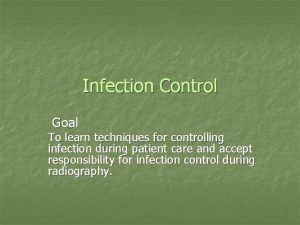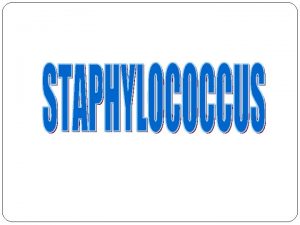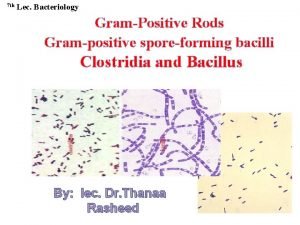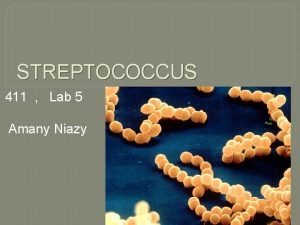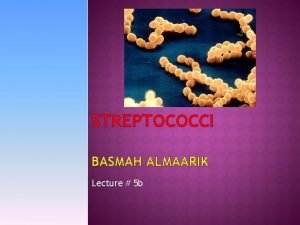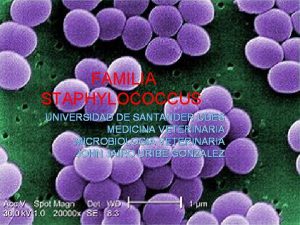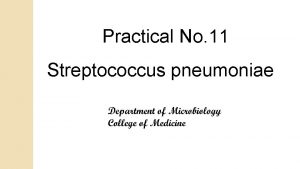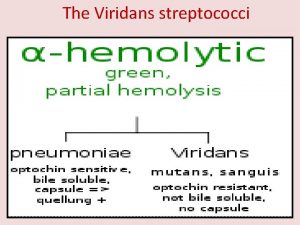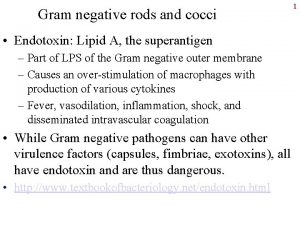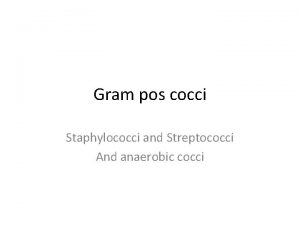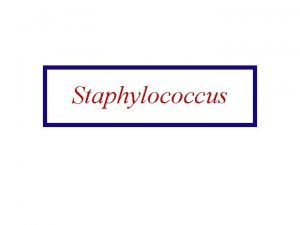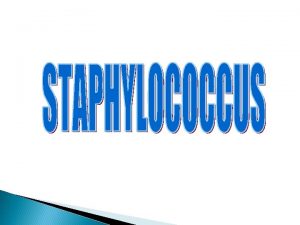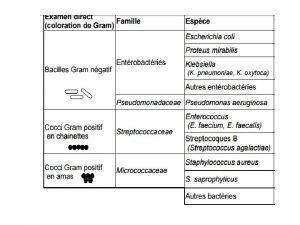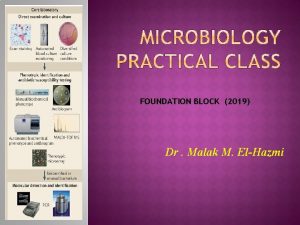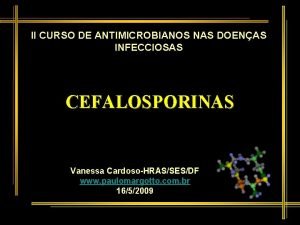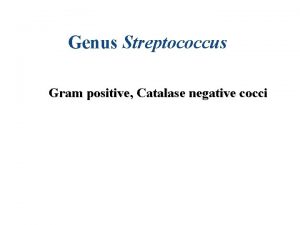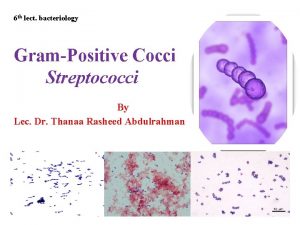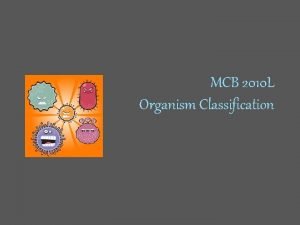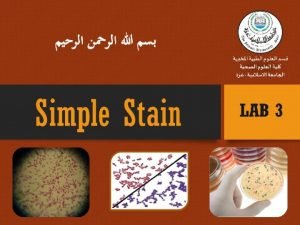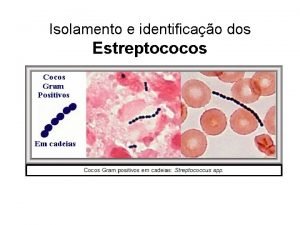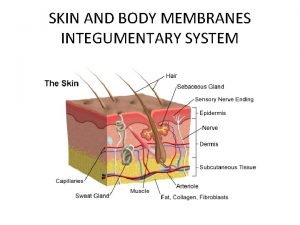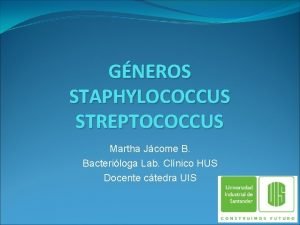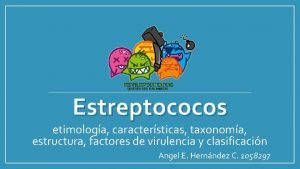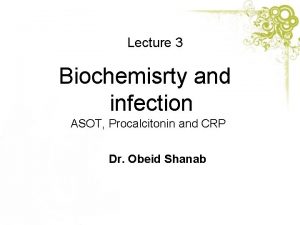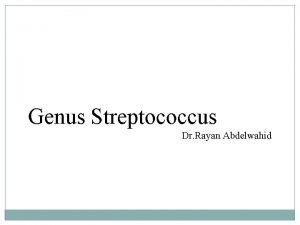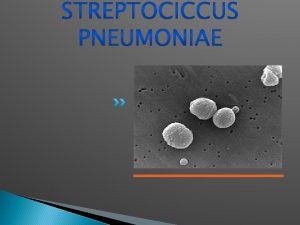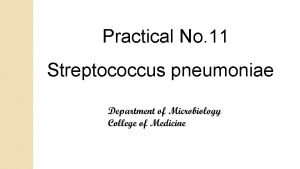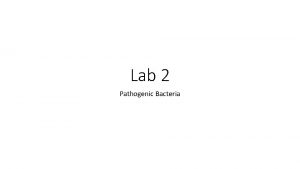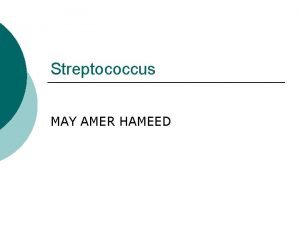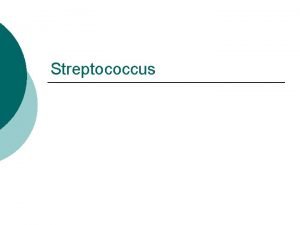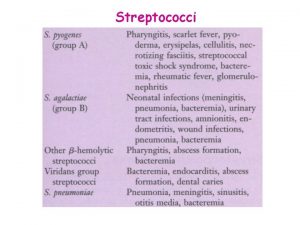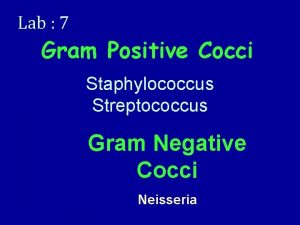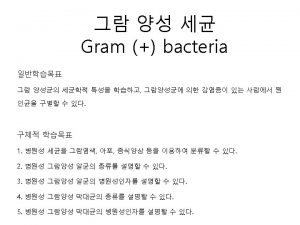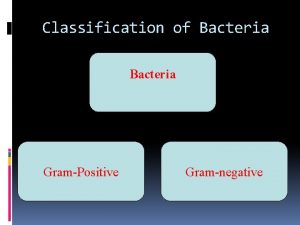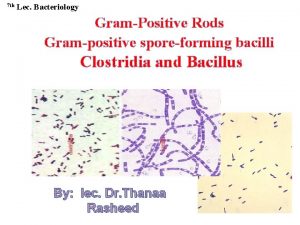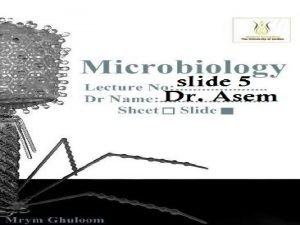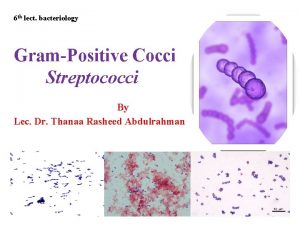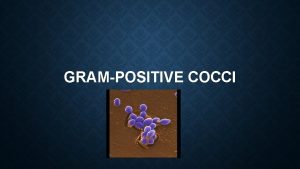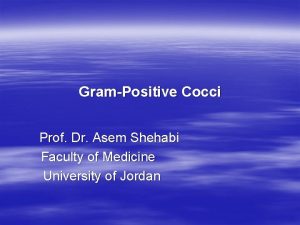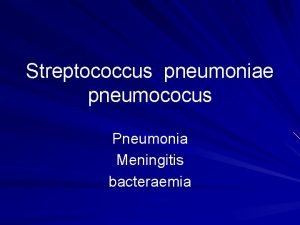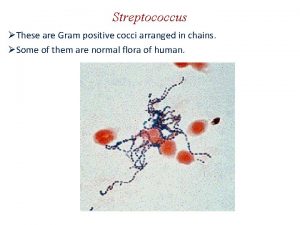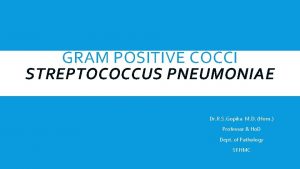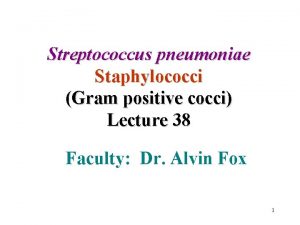Staphylococcus Morphology Grampositive cocci in clusters Staphylococcus Streptococcus







































- Slides: 39

Staphylococcus

Morphology Gram-positive cocci in clusters

Staphylococcus Streptococcus

Staphylococcus

STAPHYLOCOCCUS sp. • Gram-positive cocci • non motile • non spore forming • facultative anaerobic • catalase-positive

STAPHYLOCOCCUS sp. Coagulase-positive Coagulase-negative S. aureus S. epidermidis S. Saprophyticus

S. aureus - antigenic structure

Virulence Factors -Cell-Associated Capsule or slime layer (glycocalyx) Peptidoglycan (PG) Teichoic acid Protein A Clumping factor (bound coagulase)

Virulence Factors: Exotoxins Hemolysins - impairment of membrane, cytotoxic to phagocytes and tissue cells Leukocidin - cytotoxic to macrophages (Panton- Valentine L) Exfoliative toxin - serin proteases, causes blistering of skin TSST - multisystem effects Enterotoxins - vomiting, diarrhoea

Virulence Factors -Extracellular Enzymes Coagulase - conversion of fibrinogen into fibrin Hyaluronidase -degradation of hyaluronic acid Staphylokinase - fibrinolysis Lipases - degradation of lipids Phospholipases- degradation of phospholipids DNAse -degradation of DNA Proteases - proteolysis

Pathogenesis Acute inflammation - usually uncomplicated infection localized in portal of entry - sometimes spread generalised inf. Acute toxaemia - result of absorption of extracellular products preformed by staphylococci in the place of infection or outside

S. aureus - Infections Pyogenic infections foliculitis, furunculosis, carbunculosis wound infections impetigo abscesses mastitis septicaemia osteomyelitis pneumonia Intoxication Scalded skin syndrome Toxic shock syndrome Food poisoning

Staphylococcal inf. of oral cavity Mucosa and submucosa - sialadenitis (inflammation of parotic glands) - cheilitis angularis (inflammation of lips) - S. aureus + Candida spp. - stomatitis (inflammation of palate and tongue) Dentoalveolar abscesses, periapical abscesses Acute, chronic osteitis Osteomyelitis (mandibula) Gingivitis, periodontitis

A. Pyogenic infections Skin lesions Boils Styes Furuncles(infection of hair follicle) Carbuncles (infection of several hair follicles) Wound infections (progressive appearance of swelling and pain in a surgical wound after about 2 days from the surgery) Impetigo (skin lesion with blisters that break and become covered with crusting exudate)

Clinical Manifestations/Disease SKIN Folliculitis Boils (furuncles) Carbuncles Impetigo (bullous & pustular) Scalded skin syndrome • Neonates and children under 4 years

Deep abscesses Can be single or multiple Breast abscess can occur in 1 -3% of nursing mothers in pueperium Can produce mild to severe disease Other sites - kidney, brain from septic foci in blood

Systemic Infections 1. With obvious focus Osteomyelitis, septic arthritis 2. No obvious focus Infective endocarditis, brain abscesses 3. Associated with predisposing factors Multiple abscesses, septicaemia (IV drug users) Staphylococcal pneumonia (Post viral)

B. Toxin mediated diseases 1. Staphylococcal food poisoning Due to production of entero toxins Heat stable entero toxin acts on gut Produces severe vomiting following a very short incubation period Resolves on its own within about 24 hours

2. Toxic shock syndrome High fever, diarrhoea, shock and erythematous skin rash which desquamate Mediated via ‘toxic shock syndrome toxin’ 10% mortality rate Described in two groups of patients Associated with young women using tampons during menstruation Described in young children and men

3. Scalded skin syndrome -Also known as Pemphigus neonatorum or Ritter's disease, or Localized bullous impetigo. -Disease of young children.

3. Scalded skin syndrome -Mediated through minor Staphylococcal infection by ‘epidermolytic toxin’ producing strains. -Mild erythema and blistering of skin followed by shedding of sheets of epidermis -Children are otherwise healthy and most eventually recover

Metastatic Infections • Bacteremia • Osteomyelitis disease of growing bone • Pulmonary and cardiovascular infection

Laboratory Diagnosis: Direct Smear Examination Microscopic Examination Gram-positive cocci in Clusters Numerous polymorphonuclear cells (PMNs) may be seen Insert Figure 10 -1

Culture on blood agar • Smooth, butyrous, white to yellow, creamy • S. aureus may produce hemolysis S. aureus

S. aureus – growth on blood agar - hemolysis

staphylococci - growth on salt agar

Identification Tests: Catalase Principle: tests for enzyme catalase 2 H 2 O 2 2 H 2 O + O 2 Procedure Smear a colony of the organism to a slide Drop H 2 O 2 onto smear Observe

Catalase Test: Interpretation Presence of bubbles Positive Staphylococci Absence of bubbles Negative Streptococci

Catalase POS Staphylococcus Catalase NEG

Identification test: slide coagulase test Differentiates members within the Staphylococci Detects clumping factor found in S. aureus Procedure Place a drop of sterile water on a slide and emulsify a colony Add a drop of plasma to the suspension Observe Agglutination = Positive No agglutination= Negative

Tube Coagulase Test Detects the extracellular enzyme “free coagulase” or staphylocoagulase • Causes a clot to form when bacterial cells are incubated with plasma • Procedure • Inoculate plasma with organism and incubate at 35 -37 0 C • Observe at 30 minutes for the presence of a clot • Continue for up to 24 hours, if needed

Treatment Drain infected area Deep/metastatic infections semi-synthetic penicllins cephalosporins erythromycin clindamycin Endocarditis semi-synthetic penicillin + an aminoglycoside

Antimicrobial Susceptibility For non–beta-lactamase producing S. aureus • Use penicillin • Penicillinase-resistant synthetic penicillins (methicillin, nafcillin, oxacillin, dicloxacillin) Beta-lactamase producers break down the betalactam ring of penicillin so it inactivates antibiotic before it acts on bacterial cells

Beta lactamase production – plasmid mediated Has made S. aureus resistant to penicillin group of antibiotics - 90% of S. aureus B lactamase stable penicillins (cloxacillin, methicillin) are used

Alteration of penicillin binding proteins (Chromosomal mediated) Has made S. aureus resistant to B lactamase stable penicillins 10 -20% S. aureus resistant to all Penicillins and Cephalasporins) Vancomycin is the drug of choice

Prevention Carrier status prevents complete control Proper hygiene, segregation of carrier from highly susceptible individuals Good aseptic techniques when handling surgical instruments Control of nosocomial infections

Coagulase-Negative Staphylococci: Staphylococcus epidermidis Predominantly hospital acquired infections Skin flora gets introduced by catheters, heart valves, CSF shunts Produces a slime layer that helps adherence to prosthetics and avoidance of phagocytosis UTIs are a common result

Coagulase-Negative Staphylococci: Staphylococcus saprophyticus UTIs in young sexually active women Due in part to increased adherence to epithelial cells lining the urogenital tract Rarely present in other skin areas or mucous membranes Urine cultures If present in low amounts, it is still considered significant

Coagulase-Negative Staphylococci: Staphylococcus haemolyticus Habitat: skin and mucous membranes Rarely implicated in infections Associated with wound infections, bacteremia, and endocarditis
 Staphylococcus aureus cocci or bacilli
Staphylococcus aureus cocci or bacilli Gram positive cocci
Gram positive cocci Micrococcaceae staphylococcus
Micrococcaceae staphylococcus Grampositive rods
Grampositive rods Bile solubility test
Bile solubility test Streptococcus pneumoniae morphology
Streptococcus pneumoniae morphology Características de los estreptococos
Características de los estreptococos Bile soluble
Bile soluble Pneumococci
Pneumococci Streptococcus pyogenes morphology
Streptococcus pyogenes morphology Derivational vs inflectional morphemes
Derivational vs inflectional morphemes Rods or cocci
Rods or cocci Mannitol fermentation
Mannitol fermentation Streptococcus genus
Streptococcus genus Biochemical test
Biochemical test Staph aureus morphology
Staph aureus morphology Gram positive cocci
Gram positive cocci Cocci gram positif en amas
Cocci gram positif en amas Gram positive cocci
Gram positive cocci Curb-65
Curb-65 Coccobacilli
Coccobacilli Qcm cocci gram positif
Qcm cocci gram positif Cefalexina
Cefalexina Plasmidos
Plasmidos Streptococcus gram negative
Streptococcus gram negative Lancefield grouping of streptococcus
Lancefield grouping of streptococcus Streptococcus pneumoniae microscope
Streptococcus pneumoniae microscope Saccharomyces domain
Saccharomyces domain Streptococcus pyogenes
Streptococcus pyogenes Enterococcus spp
Enterococcus spp Streptococcus aureus
Streptococcus aureus Clasificacion de rebeca lancefield
Clasificacion de rebeca lancefield Estreptolisina o y s
Estreptolisina o y s Scarlet
Scarlet Korarchaeotes
Korarchaeotes Streptococcus
Streptococcus Classification of streptococcus
Classification of streptococcus Streptococcus aureus
Streptococcus aureus Microorganismo
Microorganismo Inulin fermentation
Inulin fermentation
